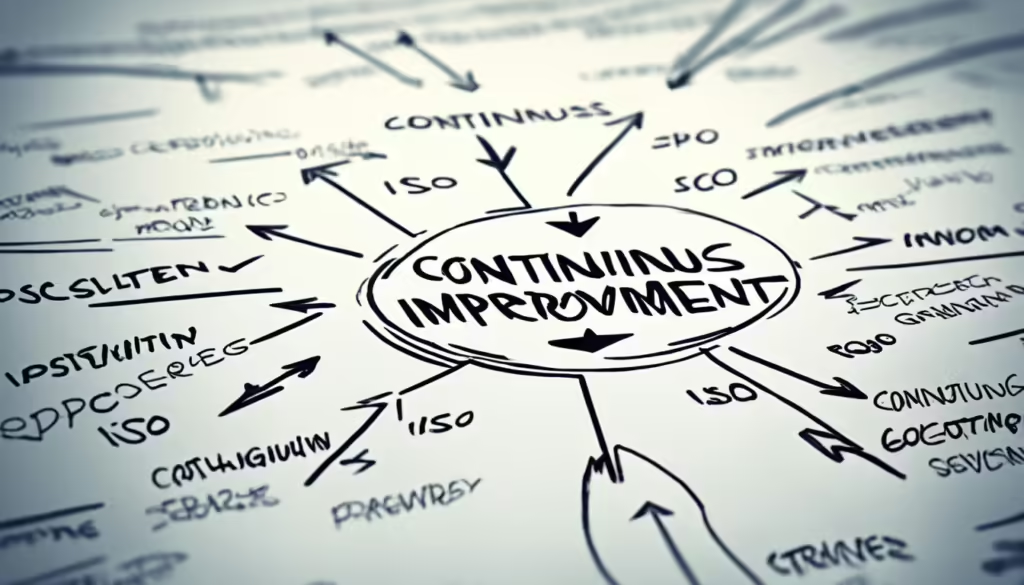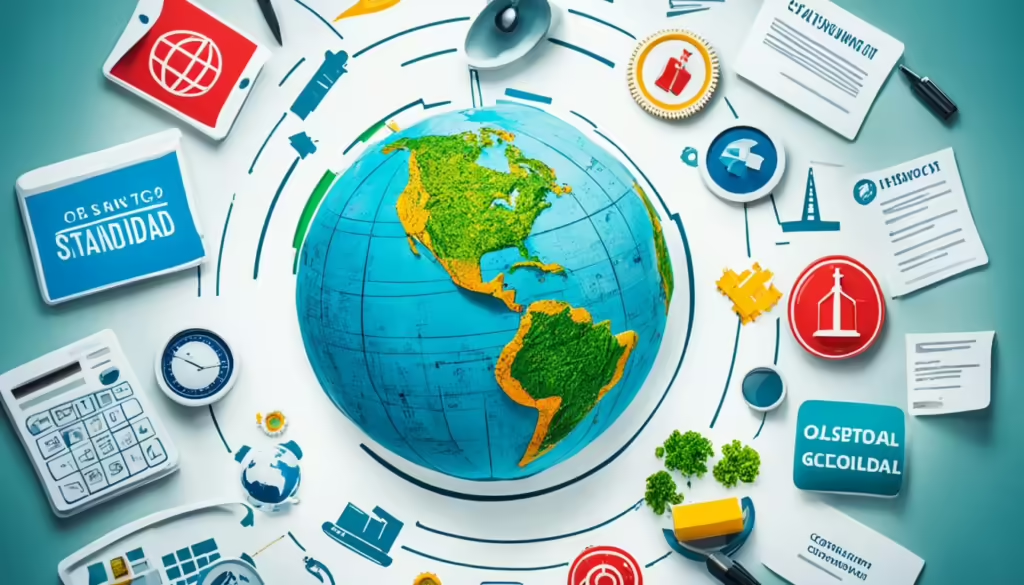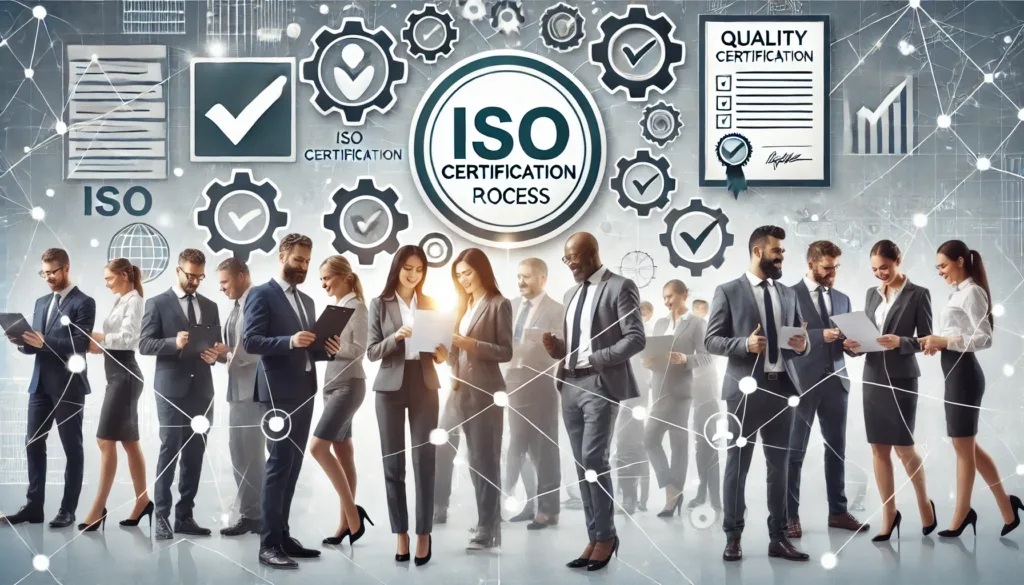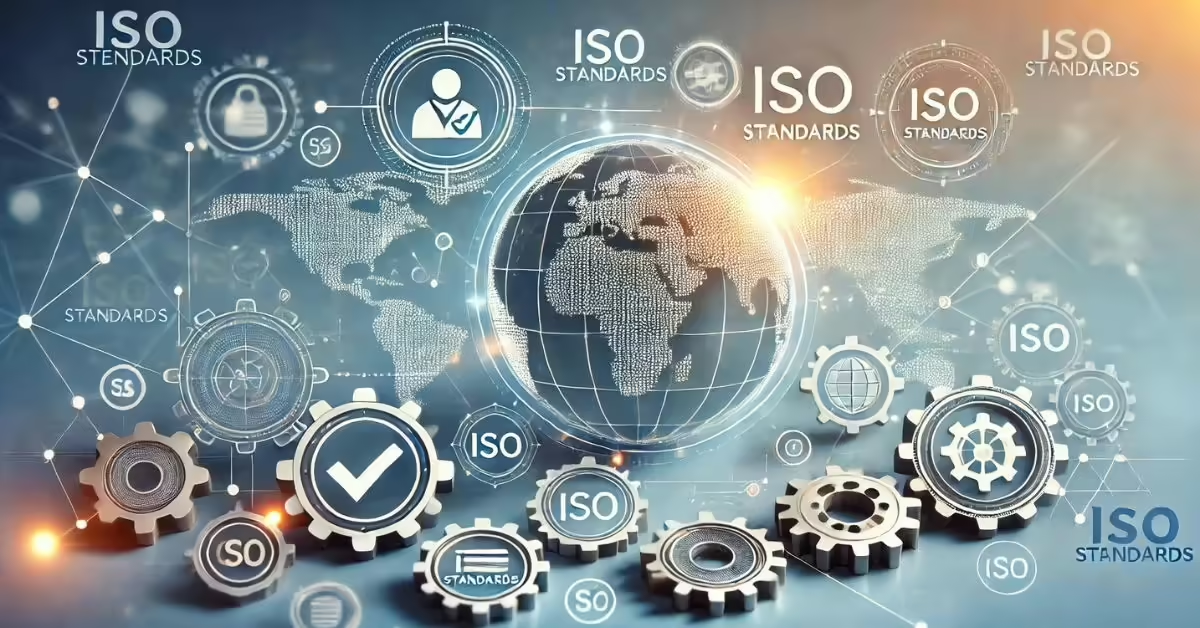Contact Us: +60 11-6158 5703
In today’s globalized world, having consistent quality and safety is key. This is where ISO standards come in. They are made by the International Organization for Standardization (ISO), a group not run by governments. These standards give guidelines and best practices for businesses all over the world.
ISO standards touch many areas, like quality management, being green, keeping information safe, and making workplaces safe. The most famous one, ISO 9001, is about quality management and is used in over 170 countries. Other big ones include ISO 14001 for being green, ISO/IEC 27001 for keeping information safe, and ISO 45001 for making workplaces safe.
ISO standards are made with a team effort. Experts and people from different industries and places work together. This way, the standards are useful, right for everyone, and can be used everywhere. By following ISO standards, companies can work better, take less risk, make customers happier, and show they care about quality and always getting better.
As we face new challenges, like moving to net zero and focusing more on ESG (Environmental, Social, and Governance) reporting, ISO keeps making standards for these issues. ISO aims to make our lives easier, safer, and better. It helps with trade, working together, and being sustainable around the world. For more info or to apply for ISO, check out our ISO Application Form.
Key Takeaways
- ISO standards give global guidelines and best practices for many areas.
- The most famous standard, ISO 9001, is about quality management.
- ISO standards are made with a team effort from experts and stakeholders.
- Using ISO standards can make things run smoother, lower risks, and make customers happier.
- ISO keeps making standards for big issues, like moving to net zero and ESG reporting.
Introduction to ISO Standards
In today’s globalized world, keeping high standards of quality, efficiency, and safety is key for businesses. The International Organization for Standardization (ISO) helps by setting global standards. These standards help businesses improve, make customers happier, and show they care about quality. With over 24,000 standards out there, ISO gives a clear guide for companies to follow best practices and keep things consistent.
Definition of ISO standards
ISO standards are guidelines that set what products, services, and processes should be like. They ensure quality, safety, and efficiency. ISO is a group of 167 countries working together. They make standards by getting experts from many fields to agree on best practices.
“ISO standards are the distilled wisdom of people with expertise in their subject matter and who know the needs of the organizations they represent – people such as manufacturers, sellers, buyers, customers, trade associations, users or regulators.” – ISO
Importance of ISO standards in today’s globalized world
ISO standards are crucial for international trade and making sure products and services are reliable. They offer many benefits, like:
- Enhancing customer confidence and satisfaction
- Improving process efficiency and effectiveness
- Reducing costs by cutting waste and errors
- Helping businesses enter new markets and trade internationally
- Ensuring legal and regulatory compliance
Over 1.5 million businesses worldwide have ISO certification. In Malaysia, thousands of companies use ISO standards to show they care about quality and safety.
| ISO Standard | Focus Area | Number of Certificates Issued Worldwide |
|---|---|---|
| ISO 9001 | Quality Management | 883,521 |
| ISO 14001 | Environmental Management | 307,059 |
| ISO 45001 | Occupational Health & Safety Management | 38,654 |
| ISO/IEC 27001 | Information Security Management | 31,910 |
For more info or to apply for ISO, check out our ISO Application Form.
As the world changes fast, using ISO standards is key for success. By following these global standards, businesses show they value quality and customer satisfaction. This helps them grow and succeed in a complex market.
History and Development of ISO
The International Organization for Standardization (ISO) started in the early 1900s. It came from the International Federation of the National Standardizing Associations (ISA), formed in 1926. World War II stopped ISA’s work, leading to the creation of a new group.
Establishment of the International Organization for Standardization
In 1947, 25 countries met in London to start a new group. This group became the International Organization for Standardization, known as ISO. ISO started in Geneva, Switzerland, aiming to help countries work together on standards.
ISO has grown a lot since starting. It now has 170 members, including 167 national groups and 4 subscriber members. The group makes money from member subscriptions, selling standards, and managing projects.
Evolution of ISO Standards Over Time
ISO has changed with the world. It now covers many areas, like tech, healthcare, and the environment. By January 2024, ISO had over 25,000 standards, thanks to over 800 committees.
| Year | Milestone |
|---|---|
| 1926 | Establishment of the International Federation of the National Standardizing Associations (ISA) |
| 1946 | Reorganization of ISA into ISO |
| 1947 | ISO officially begins operations with delegates from 25 countries |
| 2024 | ISO has published over 25,000 international standards |
ISO makes standards with everyone’s agreement. The process has six steps to make sure standards work for everyone. This way, ISO standards are accepted all over the world.
The ISO Fast Track procedure lets new technologies speed up the standard-making process. This helps ISO keep up with changes in industry and tech.
ISO standards cover many areas, like quality management and environmental care. These standards help companies improve, make customers happier, and compete globally.
For more info or to apply for ISO, visit our ISO Application Form.
Key Principles of ISO Standards

ISO is a non-governmental organization that makes international standards. It follows a voluntary and consensus-based way to make standards. Experts and stakeholders help shape these standards, and they keep improving and updating them.
ISO uses a voluntary approach to make sure its standards are the best they can be. Experts from many fields work together to agree on the best practices. This includes people from industry, consumer groups, schools, NGOs, and government.
Involvement of Experts and Stakeholders
ISO standards are made by experts from all over the world. They work in technical committees with people from different groups. This makes sure the standards work well for many industries and places.
Experts and stakeholders make sure ISO standards meet the needs of businesses and customers. This leads to better products and services for everyone.
“Developing a standard usually takes about 3 years, and every working day, around twenty-six technical meetings related to ISO take place worldwide.”
Continuous Improvement and Revision Process
ISO standards are always getting better and updated to meet new challenges. This keeps them useful and relevant in a changing world. The process looks at user feedback, new technology, and market changes.
By always improving, ISO standards help companies stay ahead in their fields. This keeps them competitive.
Some popular ISO standards that have been updated include:
- ISO 9001:2015 – Quality Management Systems
- ISO 14001:2015 – Environmental Management Systems
- ISO 45001:2018 – Occupational Health and Safety Management Systems
The latest ISO 9001, ISO 9001:2015, focuses on risk management in quality systems. This helps companies handle risks better, leading to better performance and happier customers. Following the seven principles of ISO 9001 also helps companies pass the ISO certification. It shows they are serious about quality and always getting better.
For more information or to apply for ISO, visit our ISO Application Form.
Benefits of Implementing ISO Standards
ISO standards bring big advantages to companies across many industries. They help improve the quality and consistency of products and services. This leads to happier customers and their loyalty.
ISO standards make things more efficient and save money. They help streamline processes and cut waste. For example, ISO 9001:2015 helps businesses keep getting better and focus on what customers want.
ISO standards also help with managing risks and following the law. They help companies spot and deal with risks early. This keeps businesses running smoothly and safely. Standards like ISO/IEC 27001 and ISO 45001 give advice on keeping information safe and protecting workers.
Enhancing Quality and Consistency
ISO standards set the bar for quality and consistency. Companies that follow these standards make sure their products and services are top-notch. This means they meet or beat what customers expect. Happy customers come back and tell others about it.
Boosting Customer Satisfaction
Using ISO standards shows a company cares about its customers. By taking part in making standards and following them, companies make sure they’re doing things right. This makes customers happier and more loyal.
Driving Efficiency and Cost Savings
ISO standards help make processes better and cut waste. Companies that use these standards work more efficiently and save money. They use less materials, work better together, and have less downtime. Standards like ISO 50001 can also help save on energy costs and reduce environmental impact.
Enhancing Risk Management and Compliance
ISO standards give companies the tools to handle risks well. By using standards like ISO 31000 and ISO 37001, companies can tackle threats early and follow the law. This keeps them running smoothly, protects their reputation, and avoids big fines or legal trouble.
| ISO Standard | Number of Certifications | Benefit |
|---|---|---|
| ISO 9001:2015 (Quality Management) | Over 1 million in 170+ countries | Enhances quality and consistency |
| ISO/IEC 27000 (Information Security Management) | 33,290 certificates issued | Improves information security and risk management |
| ISO 14001 (Environmental Management) | Over 300,000 in 171 countries | Reduces environmental impact and promotes sustainability |
| ISO 50001:2018 (Energy Management) | More than 20,000 certifications | Optimizes energy efficiency and reduces costs |
For more information or to submit an ISO application, please visit our ISO Application Form.
By using ISO standards, companies in Malaysia and worldwide can gain many benefits. These standards help improve quality, customer satisfaction, efficiency, and risk management. Adopting these standards helps businesses succeed and stay competitive in today’s tough market.
Major ISO Standards and Their Applications

The International Organization for Standardization (ISO) is a group of national standard-setting bodies. It creates and shares international standards for many business areas. These standards, known as “ISO” followed by a number, guide companies to make quality products and services. They help with quality, safety, efficiency, and sustainability.
ISO 9001 – Quality Management Systems
ISO 9001 sets the rules for quality management systems. It helps companies make products and services that meet customer and law needs. By using ISO 9001, companies can make customers happier, work better, and stand out in the market.
ISO 14001 – Environmental Management Systems
ISO 14001 is a standard for managing the environment. It helps companies handle their environmental effects, follow laws, and lessen their impact. Using ISO 14001 shows a company cares about the planet and being responsible.
ISO 45001 – Occupational Health and Safety Management Systems
ISO 45001 is a global standard for health and safety at work. It focuses on leadership, worker involvement, and constant improvement for a safe workplace. ISO 45001 protects workers, meets laws, and boosts company performance.
ISO/IEC 27001 – Information Security Management Systems
ISO/IEC 27001 sets the rules for keeping information safe. It helps protect things like money data and customer info from unauthorized access. Getting ISO/IEC 27001 shows a company cares about keeping information safe and builds trust with others.
“ISO standards are key for companies wanting to be the best, reduce risks, and meet customer and stakeholder needs. Using these widely recognized standards helps companies improve, grow, and stand out in the market.”
For more info or to apply for ISO, visit our ISO Application Form.
| ISO Standard | Focus Area | Benefits |
|---|---|---|
| ISO 9001 | Quality Management Systems | Improves customer satisfaction, processes, and competitiveness |
| ISO 14001 | Environmental Management Systems | Lessens environmental impact, follows laws, and shows commitment to sustainability |
| ISO 45001 | Occupational Health and Safety Management Systems | Keeps employees safe, follows laws, and boosts performance |
| ISO/IEC 27001 | Information Security Management Systems | Protects information, lowers risks, and builds trust |
Using these major ISO standards helps companies in Malaysia and worldwide. They improve their work, meet laws, and grow sustainably in a tough business world.
What Is ISO Standards and Their Significance

ISO standards are made by the International Organization for Standardization (ISO). This group brings together experts from around the world. They create standards for quality, safety, and efficiency in many industries. These standards make sure products and services are reliable and of high quality. This helps with international trade and cooperation.
ISO has many standards, like for quality management (ISO 9001), environmental management (ISO 14001), and more. These standards help organizations show they follow best practices and care about their customers. By using these standards, companies can improve and make customers happy.
| ISO Standard | Focus Area |
|---|---|
| ISO 9001 | Quality management systems |
| ISO 14001 | Environmental management systems |
| ISO 45001 | Occupational health and safety management systems |
| ISO/IEC 27001 | Information security management systems |
| ISO 22000 | Food safety management systems |
Getting ISO certification, like ISO 9001, shows a company follows global quality standards. This makes the company more credible and gives it an edge in the market. Customers trust companies with ISO certification because they know they offer quality products and services.
“ISO standards are essential for businesses looking to establish themselves as reliable, efficient, and customer-centric organizations in today’s globalized world.”
Using ISO standards has many benefits, including:
- Improved operational efficiency and cost savings
- Enhanced customer satisfaction and loyalty
- Better risk management and compliance with regulations
- Increased access to international markets and business opportunities
For more information or to submit an ISO application, please visit our ISO Application Form.
In conclusion, ISO standards are key benchmarks worldwide. They help with quality, safety, and efficiency. By using these standards, organizations in Malaysia can do better, gain trust of customers, and help the country’s economy and global competitiveness.
ISO Certification Process

Getting ISO certification shows an organization’s dedication to international standards and quality. It’s a detailed process with steps to make sure the organization meets the ISO standard, like ISO 9001 for quality management.
Steps involved in obtaining ISO certification
The first step is a gap analysis to see where the organization doesn’t meet the ISO standard. This leads to a plan for changes and improvements. Then, the organization makes these changes, like updating documents and training staff.
After making the needed changes, the organization picks an accredited body for certification. This body checks the organization through audits to see if it meets the ISO standard. These audits are done by experts who know the standard well.
Importance of choosing an accredited certification body
Picking an accredited body is key for a valid ISO certification. Accreditation checks if a body is fair, consistent, and skilled in audits. Groups like the International Accreditation Forum (IAF) and the International Laboratory Accreditation Cooperation (ILAC) help make sure bodies follow international standards.
These accredited bodies are checked often to keep their standards high. Choosing one means the ISO certification is recognized worldwide by customers and authorities.
Maintaining and renewing ISO certification
ISO certification is an ongoing process, not just a one-time thing. Certifications last three years and need a recertification audit to keep going. During this time, yearly audits make sure the organization keeps up with the standard.
To keep the certification, organizations must always follow the standard. They do internal audits, watch key performance indicators, and fix problems as they come up. This keeps them competitive, cuts costs, and leads to success over time.
| ISO Standard | Number of Certificates Issued | Number of Countries |
|---|---|---|
| ISO 9001 (Quality Management) | Over 1 million | 189 |
| ISO 14001 (Environmental Management) | Over 300,000 | 171 |
| ISO 45001 (Occupational Health and Safety) | Over 190,000 | 127 |
Many organizations worldwide have gotten ISO certificates, showing its value. By getting ISO certified, organizations show they meet international standards and are always improving. For more info or to apply for ISO, visit our ISO Application Form.
Challenges and Misconceptions about ISO Standards

ISO standards bring experts from around the world together to agree on best practices. The word “ISO” comes from the Greek “isos,” meaning equal. This shows the goal of creating a fair playing field for businesses everywhere. Yet, some people still have wrong ideas that make it hard to use these standards.
Overcoming Resistance to Change within Organizations
Implementing ISO standards often meets resistance from employees. They worry about more work or losing their jobs. To fix this, companies should explain the good things about ISO certification, like better efficiency and happier customers. Training and support can help employees adjust and make the change work.
A 2009 ISO survey showed over a million ISO 9001 certifications worldwide. This shows how valuable the standard is across different industries. But, not all countries adopt it at the same rate. For example, Arab countries saw a big increase in ISO certifications from 2004 to 2008.
| Country | 2004 | 2008 | Growth Rate |
|---|---|---|---|
| Egypt | 810 | 1,944 | 140% |
| UAE | 813 | 3,283 | 304% |
| Saudi Arabia | 280 | 776 | 177% |
| Kuwait | 77 | 206 | 168% |
Addressing the Perception of Increased Bureaucracy and Paperwork
Some think ISO certification means more red tape and paperwork. But the real gain is in making processes better. By making documents easier and focusing on the benefits, companies can lessen the burden and unlock ISO standards’ power.
ISO standards aren’t just for big companies. Small and medium-sized businesses can also use them to get better and compete globally.
“ISO certification is not a one-time achievement but rather a continuous journey of improvement, requiring ongoing compliance with standards, regular audits, and a commitment to corrective actions.”
For more info or to apply for ISO, check out our ISO Application Form.
By tackling these issues, companies can make ISO standards work well. This brings more customer satisfaction, better operations, and new market chances.
Future Trends and Developments in ISO Standards

The International Organization for Standardization (ISO) keeps up with new challenges and changes. ISO offers guidance and governance to help organizations stay ahead. This ensures they keep up with quality, safety, and efficiency in their products and services.
Emerging Areas for Standardization
ISO leads in creating standards for cybersecurity, data privacy, and making systems work together better. With technology moving fast, ISO uses new ways to make standards. This keeps them relevant. ISO also focuses on the environment, renewable energy, and sustainable development because of climate change concerns.
The ISO Foresight Framework looks at trends in Society, Technology, Environment, Economy, Politics, and Science. These trends help ISO plan for the future and make better standards.
Integration of ISO Standards with Other Management Systems
ISO standards are now blending with other management systems for better improvement. Combining ISO 9001 (Quality Management), ISO 14001 (Environmental Management), and ISO 45001 (Occupational Health and Safety) helps organizations work better together. This makes it easier to set goals and manage resources across different areas.
ISO standards are key for businesses, governments, and organizations to ensure quality, safety, and efficiency.
Increased Focus on Sustainability and Social Responsibility
ISO is focusing more on sustainability and social responsibility. Standards like ISO 26000 (Social Responsibility) and ISO 20400 (Sustainable Procurement) help organizations improve their impact on the environment and society. As people care more about these issues, adopting these standards can boost a company’s reputation.
The trend report shows how different trends connect and influence each other. It highlights the importance of inclusivity and diversity in making standards. This ensures everyone’s voice is heard and considered.
| ISO Standard | Trend |
|---|---|
| ISO 21001:2018 (EOMS) | Changes in Education Management System post-COVID |
| ISO 14001:2015 (EMS) | Increased adoption due to focus on sustainable practices |
| ISO 50001:2018 (EnMS) | Pivotal for sustainable energy management trends |
| ISO 28000:2022 (Security and resilience) | Important for supply chain security management |
For more information or to submit an ISO application, please visit our ISO Application Form.
As the world changes, ISO keeps making standards to help organizations face new challenges and chances. By keeping an eye on trends and what stakeholders need, ISO will keep being a key resource for businesses and industries everywhere.
How to Get Started with ISO Standards
Starting with ISO standards might seem hard, but it can be done with the right steps. First, pick the ISO standards that fit your business best. With over 22,782 international standards from ISO, choosing the right ones is key to your goals.
After picking the standards, like ISO 9001 for quality or ISO 14001 for the environment, do a gap analysis. This means comparing what you do now with the ISO standard’s rules. It shows where you need to get better to meet the standard.
Then, make a plan to get certified. This plan should list the steps, what you need, and when you’ll do it. It’s important to follow this plan to get ISO certified.
Seeking Guidance from ISO Consultants and Experts
Getting ISO certified can be tough, especially for newcomers. Getting help from ISO experts is a big plus. They can teach your team, help with documents, and prepare for audits. They make the process smoother and easier.
ISO standards are about getting better and improving your business. They help make your business more efficient, lower risks, and make customers happier. Over a million companies in 170 countries have ISO 9001:2015, showing its global success. For more info or to apply for ISO, visit our ISO Application Form.
